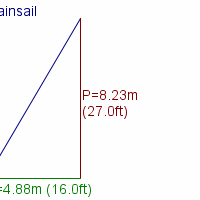Review of C Scow
Basic specs.

If you have a photo you would like to share: Upload Image
Looking for a new boat? Find a C Scow or similar boat for sale
The hull is made of fibreglass. A hull made of fibreglass requires only a minimum of maintenance during the sailing season. And outside the sailing season, just bottom cleaning and perhaps anti-fouling painting once a year - a few hours of work, that's all.
Some boats have a hull made of Wood.
CentreBoard
The C Scow is built with a centreboard keel. A centreboard keel is a pivoting lifting keel, allowing to sail both coastal and inland waters.
Sailing characteristics
This section covers widely used rules of thumb to describe the sailing characteristics. Please note that even though the calculations are correct, the interpretation of the results might not be valid for extreme boats.
What is Capsize Screening Formula (CSF)?
The capsize screening value for C Scow is 3.23, indicating that this boat would not be accepted to participate in ocean races.
The immersion rate is defined as the weight required to sink the boat a certain level.
The immersion rate for C Scow is about 87 kg/cm, alternatively 487 lbs/inch.
Meaning: if you load 87 kg cargo on the boat then it will sink 1 cm.
Alternatively, if you load 487 lbs cargo on the boat it will sink 1 inch.
Sailing statistics
This section is statistical comparison with similar boats of the same category. The basis of the following statistical computations is our unique database with more than 26,000 different boat types and 350,000 data points.
What is L/B (Length Beam Ratio)?
The l/b ratio for C Scow is 2.86.
SA/D (Sail Area Displacement ratio)
Indicates how fast the boat is in light wind:
- Cruising Boats have ratios 10-15
- Cruiser-Racers have ratios 16-20
- Racers have ratios above 20
- High-Performance Racers have ratios above 24
Sail-area/displacement ratio (SA/D ratio): 46.05
Maintenance
Dimensions of sail.

Are your sails worn out? You might find your next sail here: Sails for Sale
If you need to renew parts of your running rig and is not quite sure of the dimensions, you may find the estimates computed below useful.
| Usage | Length | Diameter | ||
| Mainsail halyard | 21.9 m | (71.8 feet) | 6 mm | (1/4 inch) |
| Jib/genoa halyard | 21.9 m | (71.8 feet) | 6 mm | (1/4 inch) |
| Spinnaker halyard | 21.9 m | (71.8 feet) | 6 mm | (1/4 inch) |
| Jib sheet | 6.1 m | (20.0 feet) | 8 mm | (5/16 inch) |
| Genoa sheet | 6.1 m | (20.0 feet) | 8 mm | (5/16 inch) |
| Mainsheet | 15.2 m | (50.0 feet) | 8 mm | (5/16 inch) |
| Spinnaker sheet | 13.4 m | (44.0 feet) | 8 mm | (5/16 inch) |
| Cunningham | 4.9 m | (16.0 feet) | 6 mm | (1/4 inch) |
| Kickingstrap | 9.8 m | (32.0 feet) | 6 mm | (1/4 inch) |
| Clew-outhaul | 9.8 m | (32.0 feet) | 6 mm | (1/4 inch) |
This section is reserved boat owner's modifications, improvements, etc. Here you might find (or contribute with) inspiration for your boat.
Do you have changes/improvements you would like to share? Upload a photo and describe what you have done.
We are always looking for new photos. If you can contribute with photos for C Scow it would be a great help.
If you have any comments to the review, improvement suggestions, or the like, feel free to contact us. Criticism helps us to improve.
